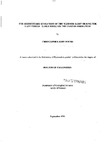THE SEDIMENTARY EVOLUTION OF THE 'EXMOOR BASIN' DURING THE LATE EMSIAN - EARLY EIFELIAN: THE LYNTON FORMATION
| dc.contributor.author | POUND, CHRISTOPHER JOHN | |
| dc.contributor.author | ||
| dc.contributor.other | School of Geography, Earth and Environmental Sciences | en_US |
| dc.date.accessioned | 2013-10-04T09:12:16Z | |
| dc.date.available | 2013-10-04T09:12:16Z | |
| dc.date.issued | 1995 | |
| dc.identifier | NOT AVAILABLE | en_US |
| dc.identifier.uri | http://hdl.handle.net/10026.1/2014 | |
| dc.description.abstract |
An integrated investigation of the sedimentological, ichnological and syn-sedimentary tectonic aspect of the late Emsian to early Eifelian Lynton Formation (Lynton Beds of previous studies) has revealed a varied mudstone-dominated shallow marine succession which accumulated in a rapidly subsiding rifted basin. The 'Exmoor Basin' developed in response to a Devonian phase of transtension associated with dextral shear along a fundamental east-west lineament to the north (the Bristol Channel Fault Zone). The Lynmouth - East Lyn Fault (a splay off the BCFZ?) was active throughout the deposition of the Lynton Formation and strongly influenced the depositional styles developed along its length. A re-evaluation of the p/subsidence curve for the 'Exmoor Basin' using the latest biostratigraphic and lithological thickness data indicates a pattern consistent with a strike-slip basin; Carboniferous thermal phase p/subsidence values suggest only 10% crustal thinning compared to values c. 50 % claimed be previous authors (Dewey 1982, Sanderson 1984). The base of the exposed Lynton Formation is characterised by extensive intraformational slide deposits and the presence of phosphatic material which represents a highstand deposit that correlates with the eustatic transgressive T-R event Ic of Johnson et al. (1985). Following a period of gradual reduction in accomodation space the sequence was punctuated by a massive influx of sand and granule grade material deposited at the base of the Lynmouth - East Lyn Fault scarp. This material was swept together into a series of offshore sand ridges and a shoreface deposit adjacent to the fault scarp. A new process-response model has been developed to describe the offshore sand ridges that were moulded by a combination of semi-permanent trade wind induced geostrophic flow, oscillatory currents and (possibly) weak tides. The central part of the Lynton Formation records a gradual upwards increase in relative accomodation space and decrease in the influence of semi-permanent currents; dysaerobic substrates became widespread and a localised anoxic mud developed offshore. The transition into the overlying Hangman Sandstone Group was marked by the southward progradation of a sandy shoreline in the face of a period of world-wide eustatic sea-level rise. The older, more northerly shoreline was dominated by longshore currents whilst the younger shoreline preserved a mixed (lower energy) storm- and wave-dominated sequence. The rate of shoreline progradation was relatively slow and the Lynton Formation - Hangman Sandstone Group boundary is markedly diachronous; the thickness of the exposed Lynton Formation varies from 200m adjacent to the Lynmouth - East Lyn Fault, where previously unrecognised outliers of the Hangman Sandstone Group occur, to 250m some 5km down-palaeoslope. Although the ichnofauna was locally diverse, with 27 distinct ichnotaxa recognised within the Lynton Formation, the succession was dominated by a gradation between straight Palaeophycus tubulraris burrows and branching Chondrites systems reflecting the response of an organism tolerant to dysaerobic conditions. The study demonstrates the value of integrating sedimentological, ichnological and structural techniques when studying Devonian marine shelf successions which accumulated m a tectonically unstable setting. | en_US |
| dc.language.iso | en | en_US |
| dc.publisher | University of Plymouth | en_US |
| dc.title | THE SEDIMENTARY EVOLUTION OF THE 'EXMOOR BASIN' DURING THE LATE EMSIAN - EARLY EIFELIAN: THE LYNTON FORMATION | en_US |
| dc.type | Thesis | |
| plymouth.version | Full version | en_US |
| dc.identifier.doi | http://dx.doi.org/10.24382/4438 |
Files in this item
This item appears in the following Collection(s)
-
01 Research Theses Main Collection
Research Theses Main


